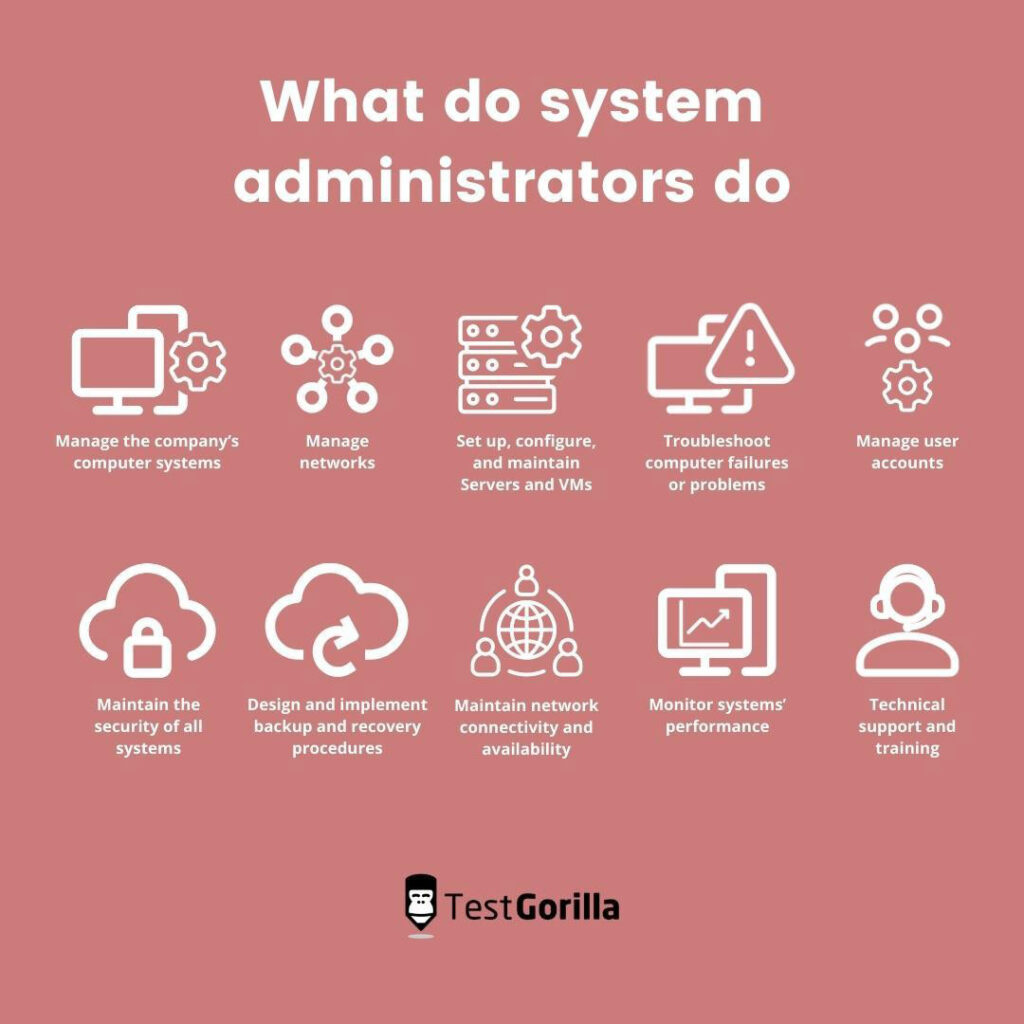How to hire the best system administrator using an online Bash test
System administrators play a vital role in maintaining your organization’s IT infrastructure and ensuring it’s secure, up to date, and functioning efficiently.
If one of your IT systems fails, the consequences can be disastrous for your business. And the longer it takes you to get it back online, the higher the risk to your performance, profitability, and reputation.
For this reason, finding and hiring the best system administrator for your company is critical. To do it successfully, you need to be able to evaluate their skills and expertise accurately and without bias.
One of the best ways to evaluate the skills of your future system administrator is to use skills tests early on in the recruitment process. Pre-employment tests such as the online Bash test enable you to quickly identify top candidates and disqualify those who don’t have the right qualifications.
In this article, we’ll discuss the role of a system administrator, the skills they need, and how you can easily hire the right sysadmin with the help of skills testing.
What do system administrators do? A system administrator’s job description
The specific tasks a system administrator is responsible for vary depending on the organization and its needs, which are usually based on its size and the systems it uses.
The following are some of the key responsibilities of system administrators:
Design, manage, maintain, and optimize the company’s computer systems, including software and hardware
Manage networks and make sure they’re secure and functional; set up and configure LAN and WAN networks
Set up, configure, and maintain Linux or Windows servers and virtual machines
Troubleshoot network, system, and computer failures or problems
Manage user accounts, groups, and permission levels
Maintain the security of all systems and ensure the company’s IT infrastructure is not exposed to security risks
Design and implement backup and recovery procedures
Maintain uninterrupted network connectivity and availability (including internet connection and email servers)
Monitor systems’ performance and availability to maintain continuous uptime and address issues as quickly as possible
Offer technical support and training to employees to make sure users have the knowledge needed to not expose the organization’s systems and data to security breaches
In short, system administrators are responsible for the smooth operation of a company’s networks and IT systems and help ensure that all employees can access the systems they need.
What skills do system administrators need to be successful?
In this section, we’ll briefly discuss the skills that system administrators require to manage and protect the organization’s IT infrastructure successfully. Again, the specific skills needed will vary from role to role and business to business, but there are some high-level abilities that most system administrators should have.
You can use the skills listed in this section to prepare a skills assessment to give to candidates during recruitment.
With TestGorilla, you can combine up to five skills tests in a single assessment and administer them to applicants all at once. This gives you a detailed overview of your applicants’ skills and enables you to easily shortlist the best candidates and invite them to an interview.
1. Problem-solving skills
An important part of a system administrator’s role is solving problems and troubleshooting different types of malfunctions. This makes problem-solving an essential skill for practically all system administrators, regardless of their seniority level and the specific systems they work with.
2. Knowledge of Windows or Linux administration (or both)
Depending on the systems your business is using, your sysadmins need relevant knowledge of Windows or Linux administration – or possibly both if your organization has complex infrastructure.
If your company is using Windows for its servers and IT infrastructure, then sufficient experience in Windows server administration and knowledge of Microsoft 365 are indispensable.
On the other hand, if you’re using Linux servers, then Linux administration skills and knowledge of the Bash shell are key. TestGorilla’s online Bash test can help you identify applicants who are familiar with the Bash shell in Linux and can use it confidently to improve your company’s efficiency.
The line between Linux and Windows is starting to blur in most organizations, so both Windows and Linux system administrators are likely to have practical experience with both operating systems.
3. Security and monitoring expertise
Securing all business data and systems is a major part of a sysadmin’s job. To achieve this, they must have the right security skills and knowledge of the best practices in user permission management, risk assessment and management, and monitoring.
Additionally, they need to stay informed on the latest security trends so that they can protect the company against major threats.
4. Communication skills
System administrators have to communicate with many teams and stakeholders and make sure everyone is on the same page regarding the company’s needs in terms of IT systems, software, and hardware. They also need to support employees by addressing specific technical issues quickly and efficiently.
Therefore, having the right communication skills is essential for sysadmins.
Other technical skills
Depending on the systems and software tools the business uses, sysadmins might require other relevant technical skills to be successful. For example, they might need to have sufficient knowledge of the following:
The best insights on HR and recruitment, delivered to your inbox.
Biweekly updates. No spam. Unsubscribe any time.
How can you hire a system administrator using an online Bash test?
In this section, you’ll find a quick step-by-step guide to hiring the best system administrator for your business with the help of an online Bash test and other skills tests. You can use the guide below to design a smooth and efficient hiring process.
Prepare a job description: First, write a comprehensive job description. Include the responsibilities of the role, must-have skills, and nice-to-have skills.
Write a job ad: Based on the job description, write a job ad. Don’t forget to mention the role’s location and the perks and benefits your organization offers.
Publish the ad on relevant job boards and start receiving applications: Once your job ad is ready, you can publish it on your website, LinkedIn, and relevant job boards. Make sure the application process is simple and straightforward.
Create a skills assessment: Create a skills assessment of up to five skills tests, which you’ll use to evaluate applicants and determine who’s fit for the job. Assess must-have technical skills (such as Bash knowledge) and non-technical skills (such as communication abilities).
Administer skills tests to all applicants: Invite all applicants to take your skills assessment. Provide candidates with enough information about your hiring process to maintain candidate engagement and ensure a positive candidate experience.
Evaluate and analyze applicants’ performance: Check the results of the skills tests to see who your best applicants are. Compare results and filter out candidates who don’t have the right skills.
Invite the best applicants to an interview: Invite the top-performing candidates to interview for the role. Again, make sure you provide enough information on the next steps of the hiring process to maintain a good candidate experience.
Conduct interviews: Conduct structured interviews to minimize bias and evaluate applicants accurately. Ask interview questions adapted to the role’s seniority level and the systems your organization is using.
Speak to previous employers: If necessary, speak to your top applicants’ previous employers to ensure they have what it takes to be successful. Always inform your candidates about this. Perhaps this goes without saying, but don’t call your applicants’ current employers without discussing it with them first.
Make a hiring decision and extend an offer to the best applicant: By this point, you’ll have all the info you need, so make a hiring decision and send an offer to the best candidate. Discuss the contract’s terms and start date.
Hire the best system administrator with the help of an online Bash test
System administrators play a critical role in maintaining your organization’s IT systems and ensuring everything runs smoothly and efficiently. It’s particularly important to make the right hiring decision to avoid exposing your company to security risks.
However, hiring your next system administrator won’t be difficult if you have the right hiring tools in your recruitment toolbox. Skills tests like TestGorilla’s Bash test can help you make an accurate, objective, and unbiased hiring decision.
Keep your company’s systems protected against cyber threats and its infrastructure up and running at all times. Hire the best system administrator for your business with TestGorilla. Sign up for a TestGorilla free plan.
Related posts
You've scrolled this far
Why not try TestGorilla for free, and see what happens when you put skills first.




















